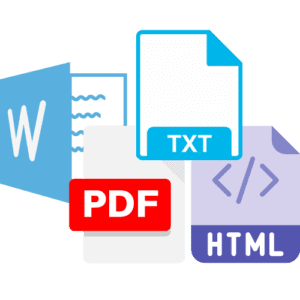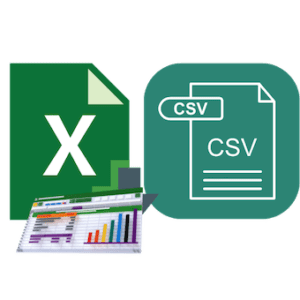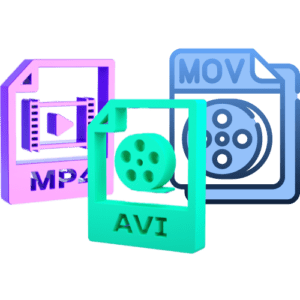At some point during your career there is a good chance you have been asked to send a particular file type to either test something, create digital or printed output or to sign something.
For example, if you’re working with a graphic designer you may be asked to share common image-based files such as .TIF, .JPG, .PNG or .PDF. These file types could be used for logos, photos or image graphics. First question you want to have answered is are they being used for print or digital purposes (online)?
If you’re working with data or technology you might be asked to provide common file types like .CSV, .TXT, or .XLS. Not all systems are designed to import all file types. And, not all systems can export these data types.
If you’re writing reports, a letter or simply taking notes and need to send the files electronically the common textfiles types to use are are .DOC, .TXT or .PDF.
Why Use Specific File Formats?
Each file format have a specific purpose, and if you don’t know which format is best to use, you won’t necessarily get the best results. Additionally, it could cost you more dollars if the person receiving the files needs to change or manipulate the files before using them for the intended purpose. To capitalise on the benefits of specific file types, let’s go through some of the most common.
Common Image-based File Types
An image file is a file format for a digital image. It is important to understand different formats to ensure the image quality and resolution are preserved. Let’s look at each file type so you can choose the file format wisely next time.
1/ .JPEG / .JPG – Joint Photographic Expert Group format is the most common image file type. When you send high-resolution (a.k.a “hi-res”) to your customer or need pictures for your business, the most suitable file format to use is JPEG/JPG. This file type compresses your image but also maintains its quality.

2/ .PNG – Portable Network Graphic file format is a raster image file type because it uses pixels to display high-quality photos and graphics. It is a popularly used file format for a picture because it can manage graphics with transparent or semi-transparent backgrounds. Thus, making it easier to put the images directly in the background without investing extra time in editing the background.

3/ .TIFF / .TIF – Tag Image File format stores raster graphics and image information. Before editing high-quality images, you should store them in the .TIFF/.TIF format to avoid lossy file formats. When you need to scan important documents or print high-quality items, you should prefer saving them in this format. This can help you print images of higher quality. Remember that this is a large file type, so it is better to use this format for your web pages.

4/ .GIF – Graphics Interchangeable format is one of the most widely used graphic file types across social media. GIFs are created by using individual images to build basic animations in short-form but with speed and high-impact output. Read more..

There are several other image-based file format types you can learn more about here > Read more…
And, if you haven’t already discovered Canva, then we would strongly recommend you do. Sign up to premium, too. It’s totally worth it!
Common Text-based File types
You can use document files when you receive or send them to team members or clients. Here are the most common document file types you may come across:
1/ .DOC – A word-processing document initially created by Microsoft (‘MS Word’). This is the most commonly used word processing application because it supports easy formatting text, images, tables, graphs, charts, page formatting, and print settings. MS Word is available either offline via desktop app or in the cloud, although there are some differing functionality between the two. Google Workspace offers Google Docs; 100% cloud-based file type accessible from anywhere at anytime. Apple also has it’s own word-processing variation called Apple ‘Pages’.
MS Word, Google Docs or Apple Pages helps perform a wide range of tasks. People can easily and quickly create reports, write and merge data with letters and graphs or simply capture their thoughts. It is simple to share and edit this type of document across many environments.
.DOC files should not be used to store system data.
2/ .TXT – Text format supports simple text documents where you can write notes, instructions, and any plain text. If you do not want advanced fonts, formatting, or tables, this format is best for you; otherwise, you should work with MS Word, Google Doc or Apple Pages.
.TXT files can be used to store system data.
3/ .PDF – Portable Document Format is widely used for ease of securing document layout transfer i.e. allowing you to maintain the original layout. This is the suitable format when you need a document that may require signing or output approval. It is often used for printing one off or recurring documents and for high-volume printing. PDFs are editable, but it is much harder for changes or fraud to occur without someone noticing.
.PDF files should not be used to store system data.
4/ .HTML – People creating websites or web content use Hypertext Markup Language files. These files are written in HTML, and when opened, automatically construct the web page, making it easier for the customer to view the webpage directly. They don’t need to understand the HTML language. A variation to common HTML is email-based HTML. This file type has become critical to creating highly engaging email that also allows interactive, functional and highly-trackable cusotmer behaviour. Read more…
There are several other text-based file format types you can learn more about here > Read more…

Text-based Data File Types
1/ .XLS / .XLSX – Microsoft Excel worksheets aka MS Excel or .XLS. Excel is commonly used to keep track of data like numbers, formulas, or text. You should use this format to track progress for a task or store data more sophistically. If you want to share spreadsheets, graphs, or databases in your workplace, you should use this format. It makes sure any data analysis is much easier and saves time.
.XLS files can be used to hold data.
2/ .CSV – Comma-separated Values a.k.a .CSV file. A plain text file type that is commonly used for storing data by delimiting data entries with commas. They are often used with data needs to be compatible with many different programs. Read more…
.CSV files can be used to store data.
There are several other data file format types you can learn more about here > Read more…

Common Video File Types
You may need video files for your company website, marketing campaigns, or presentations. Here are some common file types you will come across:
1/ MP4 / MPEG – Moving Picture Experts Group video file a.k.a .MP4/.MPEG allows you to store a large amount of video and audio information in a smaller size to store many videos without any storage issues.
Most PCs and mobile phones can open mp4 format files easily, so it is better to send videos to your clients using MP4 file format. You should keep in mind that it accurately stores the video and audio, but it has a lower resolution.
2/ AVI – Audio Visual Interleave a.k.a .AVI file format is a video file format created by Microsoft. It is a large file type, which means it will take up a lot of the storage on your system, but it maintains the high quality of your video even after making multiple saves and changes. If you want to maintain the high-quality videos you need for your business, workplace, presentations, or to send a client, it is recommended that you use this file format.
3/ .MOV – Movie file format a.k.a .MOV file is a common video file often used to store data for movies, TV shows or home video. It uses the multimedia container file format, QuickTime. This file format was developed by Apple and is used mostly by video editors because of it’s support for high-quality video. is popular for streaming services and websites because it is small and so much easier to use.
There are several other video format types you can learn more about here > Read more…

The Final Word
The purpose of this article is to highlight and help some readers better understand the need to know the correct fit-for-purpose file type.
If you are asked to provide image-based files, the most common file type is a hi-resolution (“hi-res”) .JPG/JPEG, .TIFF or PNG file. The higher the resolution the easier it is to work with. Note, these files are best used for online/digital as they are made up of RGB colour configurations. If you’re printing, use “hi-res” PDFs. These file types are made with the CMYK colour configurations embedded.
When asked to supply an extract of data, the most commonly used file type is .XLS or .CSV. These days most modern systems should export this file type. Do not supply .PDF or .DOC files with data stored. There is not much any data-centric organisation can do with this file type without additional work.
Follow some of these baseline tips and you find yourself saving time and very likely, saving money.
At Dovetail Group, we provide simple, yet effective revenue growth services and solutions to make everything work as it should.


